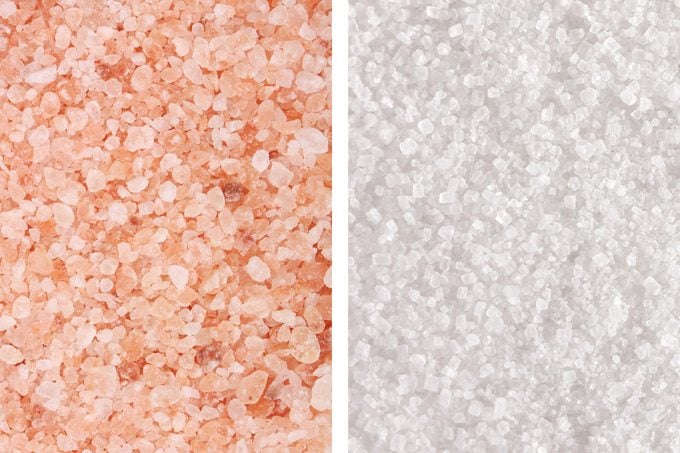Pink Himalayan Salt vs. Sea Salt: Which Is Better for You?
Updated: Jul. 01, 2022
Health experts discuss what you need to know to choose between sea salt and pink Himalayan salt, and how eating salt affects your health.
Our editors and experts handpick every product we feature. We may earn a commission from your purchases.
It’s a tale as old as time. You enter the grocery store with the innocent intention of purchasing salt—just one bottle, nothing fancy. Yet, as you stroll down the aisles, scanning the shelves for the sodium selection, you become overwhelmed by the options. There’s table salt, sea salt, Himalayan pink salt…the list goes on. You’re short on time, exhausted from a long day, and not amused by the mind game that the salt manufacturers and your grocery store have clearly teamed up to play on you. Your mind races as you internally cry, “which should I choose?!” Don’t worry, we can help.

What is sea salt?
Sea salt is created through the evaporation of ocean water or saltwater lakes. Unlike table salt, which is mined from the ground and processed to filter out excess minerals and include anti-clumping additives, sea salt gets minimal processing. This accounts for its large, crystalline shape and recent popularity among health-conscious consumers and food manufacturers. Additionally, the evaporation process enables sea salt to preserve traces of minerals that our bodies need, such as potassium, calcium, and magnesium, according to the American Heart Association.
While the words “natural” and “unprocessed” may sound appealing, licensed clinical psychologist and certified nutrition coach Candice Seti warns against rushing to celebrate sea salt. Seti explains that “if it is darker in hue, it has more impurities, and with the rampant pollution in our world’s waters, sea salt can contain trace amounts of heavy metals.” Carolyn Dean, MD, ND, author and founder of RNA Reset, a supplements company, adds that sea salt can also contain traces of “microplastics from polluted waters and plastic waste.” Although sea salt is a more “natural” choice than table salt, sprinkling it on your food does come with the possibility of consuming small amounts of undesired materials. Think you might be eating too much salt in general? You may want to avoid these 13 surprisingly high-sodium foods.
What is pink Himalayan salt?
If you’ve ever come across pink Himalayan salt at the grocery store, you might have wondered whether you could trust such a colorful product. Rest assured, however, the pink color is completely normal. According to William Li, MD, author of Eat To Beat Disease: The New Science of How Your Body Can Heal Itself, pink Himalayan salt “comes from the Khewra Salt Mine in Pakistan, where the mineral content there produces a unique pink coloration.”
Since pink Himalayan salt is hand-mined and ground, producers of this salt argue that it is even more natural than sea salt. In terms of its composition, pink Himalayan salt does have traces of more beneficial minerals than sea salt. While sea salt contains bits of 72 particles, pink Himalayan salt has “all 84 essential trace elements required by your body,” explains Dr. Dean. This disparity makes most health specialists rate pink Himalayan salt higher than other salts, according to Seti.

So, which is better for your health?
Now that you have the facts about both types of salt, you are probably wondering which type is actually better for your health. “Generally speaking, the fewer additives and anti-caking agents you ingest, the better you’ll be,” Seti asserts. At first glance, the microplastics, metals, and fewer helpful elements that are found in sea salt seem to indicate that pink Himalayan salt is the smarter selection.
However, the quantity of “harmful” materials in sea salt is actually so small that the health impacts are insignificant, according to a 2017 study in Scientific Reports. While the discovery of artificial plastics in food products is surely a call for humanity to reduce its pollution and waste, it does not have any remarkable bearing on which type of salt you should buy. In other words, neither of these salts are worse for your health, but too much of any salt “can lead to high blood pressure, cellular disruption, and even strip the lining of the stomach to increase the risk of stomach cancer,” Dr. Li informs. These are only three of the many ways that consuming too much salt is harming your health.
We know what you’re thinking now: even though sea salt is not worse for your health, the benefits of pink Himalayan salt outweigh that of sea salt. However, while pink Himalayan salt is composed of a greater number of helpful elements than sea salt, “the trace minerals that give unique taste or coloration are present in too minute a quantity to have any proven health impact,” says Dr. Li. Therefore, neither one of these salts is proven to be better for your health either.
How do we choose between them?
If you’re attracted to the rosy glow of pink Himalayan salt, add some color to your plate with this sparkling sodium. Alternatively, if you distrust avocado toast, elaborate milkshakes, and other food trends that constantly dominate your social media, stick to traditionally colored sea salt.
According to Dr. Li, “salt, chemically known as sodium chloride, regardless of its source is vital for health. Salt helps our body regulate blood pressure, assist in nerve function, and helps your cells perform their function to keep organs healthy.” Since sea salt and pink Himalayan salt are both excellent sources of sodium chloride, select the salt you most desire!















